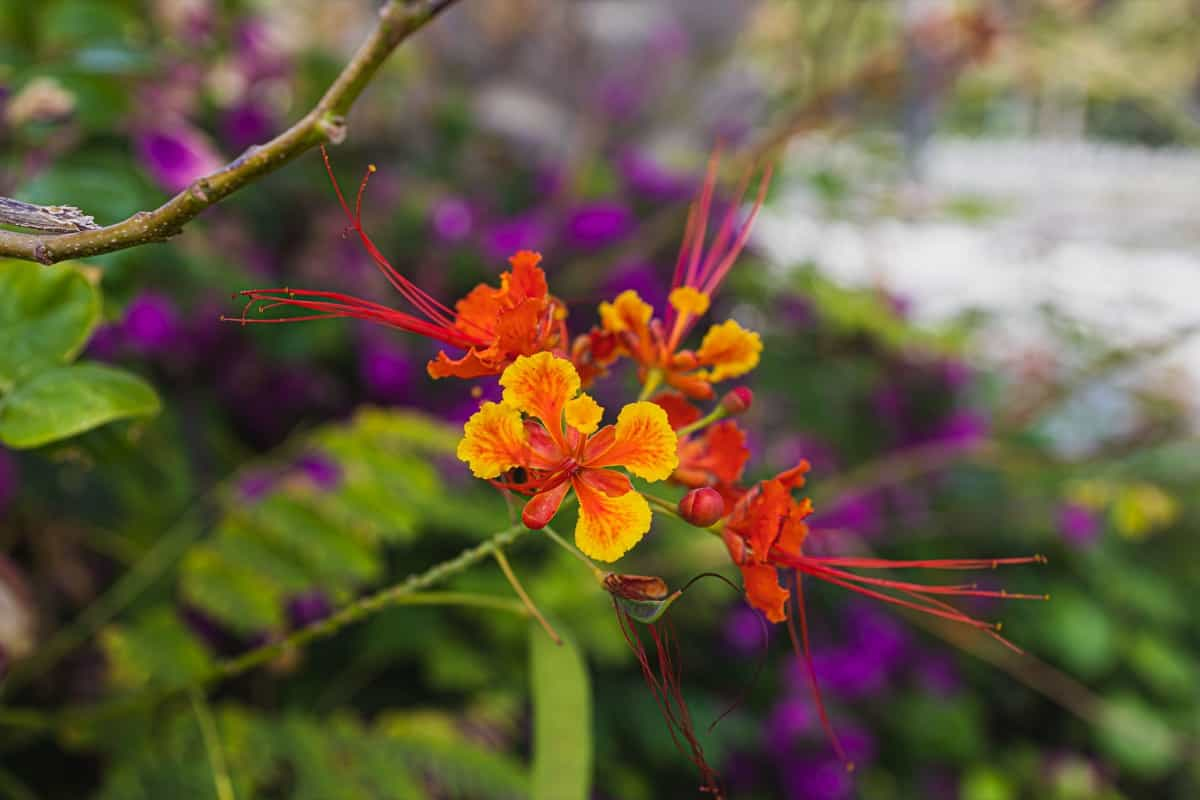The Mexican Bird of Paradise is a versatile plant that can bring vibrancy and beauty to any garden or landscape. With its striking orange flowers, drought tolerance, and low maintenance requirements, it is the best choice for both beginner and experienced gardeners alike. From propagation techniques to creative landscaping ideas, this ultimate guide has provided you with all the information you need to grow and care for Caesalpinia mexicana successfully.

Introduction to Mexican Bird of Paradise
Overview of Caesalpinia mexicana
This stunning plant is not only a favorite among gardeners for its striking appearance but also holds historical significance in various regions. With its bright orange flowers and fern-like leaves, it adds a pop of color to any landscape.
Historical and Cultural Significance
Caesalpinia mexicana has been used traditionally for medicinal purposes by indigenous communities, showcasing its importance beyond just aesthetics. Its resilience in different climates and soil conditions makes it the best choice for both novice and experienced gardeners alike. Whether you’re looking to enhance your outdoor space or dive into the rich history behind this botanical wonder, Mexican Bird of Paradise is sure to captivate with its beauty and heritage.
Choosing the Right Location
Sunlight Requirements for Optimal Growth
When it comes to Growing Caesalpinia pulcherrima, choosing the right location is key for optimal growth. These vibrant beauties thrive in full sunlight, so make sure to place them where they can soak up those rays all day long.
Ideal Soil Conditions and Drainage
When it comes to the best soil for the Mexican Bird of Paradise, well-draining soil is a must. Mexican Bird of Paradise plants don’t like wet feet, so ensure the soil allows excess water to flow away easily. A mix of sandy and loamy soil works best. When planting your Caesalpinia mexicana, consider the drainage in the area. Avoid low-lying spots that could result in waterlogging during heavy rains. Instead, opt for slightly elevated ground where water can drain away efficiently.
Planting Your Mexican Bird of Paradise
Best Time to Plant
When it comes to planting the Mexican Bird of Paradise, timing is key. The best time to plant this vibrant beauty is in the spring when the soil has warmed up and frost danger has passed.
Step-by-Step Planting Guide
Choose a sunny place with well-drained soil for optimal growth. Dig a hole, remove the Mexican Bird of Paradise plant from its container, and place it in the center of the hole. Backfill with soil, making sure to tamp it down gently to remove any air pockets. Water regularly after planting to help settle the soil around the roots. Mulch around the base of the plant to retain moisture and suppress weeds.
In case you missed it: 10 Reasons Why Your Flower Plant is Not Blooming: Remedies and Treatment

Watering and Nutritional Needs
Establishing a Watering Routine
Watering the Mexican Bird of Paradise is crucial for its health and growth. Establishing a consistent watering routine will help maintain optimal soil moisture levels. This plant thrives in well-draining soil, so be mindful not to overwater. During the growing season, ensure the plant receives regular deep watering sessions rather than frequent shallow ones. This will encourage deep root growth and overall plant resilience. In hotter months, monitor the soil moisture closely to prevent dehydration.
Essential Nutrients and Fertilization Schedule
When it comes to Fertilizing Caesalpinia pulcherrima, providing essential nutrients through fertilization is key. Use a balanced fertilizer specifically formulated for flowering plants during the active growing period for best results. Remember, moderation is key when fertilizing – too much can harm the plant rather than help it flourish. Stay attentive to your Mexican Bird of Paradise’s nutrient needs to promote healthy growth and vibrant blooms throughout the year.
Pruning and Maintenance of Caesalpinia mexicana
When and How to Prune
Pruning the Mexican Bird of Paradise is essential to keep it healthy and flourishing. Regular pruning helps shape the plant, remove dead or damaged branches, and promote new growth. When it comes to pruning your Mexican Bird of Paradise, aim to do so in late winter or early spring. Trim back any overgrown or crossing branches to maintain a balanced form. Remove any diseased or pest-infested parts promptly to prevent further spread. During the growing season, you can lightly prune to control size and shape as needed.
Seasonal Maintenance Tips
As part of seasonal maintenance, ensure your Caesalpinia mexicana receives adequate water, sunlight, and nutrients for optimal health. Keep an eye out for any signs of pests or diseases that may require attention. Regularly monitoring your plant will help you catch issues early on before they become severe complications.
Pest and Disease Management
Common Pests and How to Combat Them
Common Mexican Bird of Paradise pests are aphids, spider mites, and whiteflies. These cause damage to the leaves and stems if left unchecked. To combat these pesky critters, you can use neem oil as a natural remedy.
Identifying and Treating Diseases
When it comes to Caesalpinia pulcherrima diseases, keep an eye out for fungal infections like powdery mildew or root rot. If you notice any symptoms of the disease on your plant, promptly treat it with appropriate fungicides or by adjusting your watering routine. By staying vigilant and taking proactive measures, you can keep your Mexican Bird of Paradise healthy and thriving in your garden.
Encouraging Blooms
Factors Influencing Flowering
Encouraging blooms in Mexican Bird of Paradise is a rewarding experience that can bring vibrant colors and beauty to your garden. One key factor influencing flowering is sunlight. When it comes to Mexican Bird of Paradise sunlight needs, it requires 6-8 hours of direct sunlight daily for optimal blooming. Proper watering is essential.
In case you missed it: Effective Strategies for Managing Mango Flowers to Boost Yields

Fertilizing regularly with a balanced fertilizer high in phosphorus can promote healthy flower production. Pruning back leggy growth and spent flowers can redirect energy toward new blooms, so don’t be afraid to trim when needed.
Tips to Maximize Blooming
Paying attention to the Temperature tolerance of the Mexican Bird of Paradise and protecting your plant during cooler months can help prevent damage and encourage continued blooming.
Propagation Techniques of Mexican Bird of Paradise
Propagating from Seeds
Propagation of Mexican Bird of Paradise can be an exciting journey for plant enthusiasts seeking to expand their green thumb skills. One way is Seed propagation of Caesalpinia pulcherrima, which requires a bit more patience but can be rewarding. To start, collect fresh seeds from mature pods and soak them in warm water overnight before planting in well-draining soil.
Propagating from Cuttings
Alternatively, propagating from cuttings offers a quicker method to grow new plants. Select a healthy stem cutting with at least two nodes and remove any leaves near the base. Dip the Mexican Bird of Paradise cutting end in rooting hormone and plant it in peat moss and perlite mixture. Keep the soil moist and provide indirect light for optimal growth.
Winter Care and Protection for Mexican Bird of Paradise
Preparing for Cooler Temperatures
As the temperatures drop, it’s essential to ensure your Mexican Bird of Paradise is well-prepared for the winter months ahead. Providing adequate care and protection during this time will help your plant thrive when spring comes around again. Before winter sets in, make sure to remove any dead leaves from around the base of the plant.
Overwintering Strategies
When it comes to overwintering Mexican Bird of Paradise, consider applying a layer of mulch around the base of your Caesalpinia mexicana to insulate the roots and retain moisture. If you live in an area with particularly harsh winters, you may need to consider additional protection, such as wrapping the plant with burlap or moving it indoors temporarily. Be sure to monitor weather forecasts and adjust your strategy accordingly.
Troubleshooting Common Issues in Mexican Bird of Paradise
Dealing with Leaf Yellowing and Drop
This common issue can be attributed to various factors, including overwatering, nutrient deficiencies, or inadequate sunlight. To address the Mexican Bird of Paradise leaf drop, ensure proper drainage in the soil to prevent waterlogging and adjust your watering routine accordingly.
Addressing Lack of Flowers
If you’re facing a lack of flowers on your Caesalpinia mexicana plant, it may be due to insufficient sunlight or nutrients. When it comes to Troubleshooting Mexican Bird of Paradise problems, make sure your plant is receiving adequate sunlight each day and consider fertilizing with a balanced fertilizer rich in phosphorus to encourage flowering.
In case you missed it: From Seedling to Bloom: Tailoring DIY Flower Plants Fertilizers to Different Growth Phases

Conclusion
Whether you are a seasoned gardener or a beginner, the Mexican Bird of Paradise is a vibrant and low-maintenance plant that can add exotic beauty to your garden. From its propagation through seeds or cuttings to its planting and care, this plant offers an array of possibilities for creating a stunning outdoor space. By following these guidelines on how to propagate, plant, and care for this striking plant, you can enjoy its colorful blooms year-round.
- Flower Garden Designs and Layouts for Beginners
- Planting and Spacing Techniques in Papaya: A Beginner’s Guide
- Growing Gold: Essential Techniques for Planting Pineapples
- How to Make Kalanchoe Plant Bushy: Home Remedies and Solutions
- 11 Reasons Why Your Gardenia is Not Blooming: Home Remedies and Solutions
- Eco Elegance: The Guide to Designing a Drought-Tolerant Landscape
- Gardening on a Slope: Strategies for Hillside Landscaping
- Nourish and Flourish: Top Organic Mulches for Thriving House Plants
- Everything You Want to Know about Indian Mogra Flower: Discover Uses and Growing